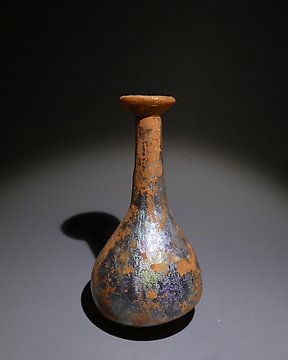
Starożytny Rzym Wyroby garncarskie Unguentarium. 8,2 cm wys. I - II wiek n.e (Bez ceny minimalnej )
Nr 82814495

Nr 82814495

ITEM: Miniature bowl
MATERIAL: Pottery
CULTURE: Iron Age
PERIOD: 1st millenium B.C
DIMENSIONS: 32 mm x 54 mm diameter
CONDITION: Good condition, repaired
PROVENANCE: Ex French private collection, acquired between 1980 - 1990
Iron Age pottery represents a significant aspect of material culture during the period characterized by the widespread use of iron tools and the development of complex societies in various regions around the world. Pottery played a crucial role in daily life, serving as vessels for cooking, storage, and ceremonial purposes. Iron Age pottery exhibits considerable diversity in terms of forms, styles, and decorative techniques, reflecting the cultural diversity and technological advancements of the time. The production of pottery during the Iron Age relied on local clay sources and traditional methods of hand-building or wheel-throwing, although innovations such as the use of kilns for firing ceramics emerged in some regions.
One distinctive feature of Iron Age pottery is its regional variation, with different cultural groups developing unique pottery traditions influenced by factors such as geographical location, technological capabilities, and social practices. In Europe, for example, Iron Age pottery can be classified into various regional styles, including the La Tène style of Central Europe and the Corded Ware culture of Northern Europe. These styles exhibit differences in vessel shapes, surface treatments, and decorative motifs, reflecting the diverse cultural landscapes of Iron Age societies across the continent. Similarly, in other parts of the world, such as the Near East, Asia, and Africa, Iron Age pottery reflects a rich tapestry of local traditions and artistic expressions.
In addition to its utilitarian functions, Iron Age pottery often served symbolic and ritualistic purposes within society. Many pottery vessels from this period were adorned with elaborate decorations, including incised patterns, painted designs, and symbolic motifs such as animals, plants, and geometric symbols. These decorations may have held religious or spiritual significance, representing cosmological beliefs, ancestral connections, or mythological narratives. Furthermore, pottery played a role in trade and exchange networks, with certain types of vessels serving as prestige goods or markers of social status.
Comes with Certificate of Authenticity and Export license.
If you bid outside the European union and win the item, we will have to apply for an export licence for your country and shipping will take 3 to 5 weeks.
Jak kupować w serwisie Catawiki
1. Odkryj coś wyjątkowego
2. Złóż najwyższą ofertę
3. Dokonaj bezpiecznej płatności